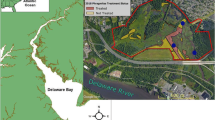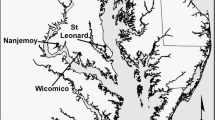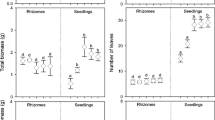Abstract
Invasive plants, such as Phragmites australis, can profoundly affect channel environments of large rivers by stabilizing sediments and altering water flows. Invasive plant removal is considered necessary where restoration of dynamic channels is needed to provide critical habitat for species of conservation concern. However, these programs are widely reported to be inefficient. Post-control reinvasion is frequent, suggesting increased attention is needed to prevent seed regeneration. To develop more effective responses to this invader in the Central Platte River (Nebraska, USA), we investigated several aspects of Phragmites seed ecology potentially linked to post-control reinvasion, in comparison to other common species: extent of viable seed production, importance of water transport, and regeneration responses to hydrology. We observed that although Phragmites seed does not mature until very late in the ice-free season, populations produce significant amounts of viable seed (>50 % of filled seed). Most seed transported via water in the Platte River are invasive perennial species, although Phragmites abundances are much lower than species such as Lythrum salicaria, Cyperus esculentus and Phalaris arundinacea. Seed regeneration of Phragmites varies greatly depending on hydrology, especially timing of water level changes. Flood events coinciding with the beginning of seedling emergence reduced establishment by as much as 59 % compared to flood events that occurred a few weeks later. Results of these investigations suggest that prevention of seed set (i.e., by removal of flowering culms) should be a priority in vegetation stands not being treated annually. After seeds are in the seedbank, preventing reinvasion using prescribed flooding has a low chance of success given that Phragmites can regenerate in a wide variety of hydrologic microsites.





Similar content being viewed by others
References
Ailstock MS, Norman CM, Bushmann PJ (2001) Common reed Phragmites australis: control and effects upon biodiversity in freshwater nontidal wetlands. RestorEcol 9:49–59
Albert A, Brisson J, Belzile F, Turgeon J, Lavoie C (2015) Strategies for a successful plant invasion: the reproduction of Phragmites australis in north-eastern North America. J Ecol 103:1529–1537
Belzile F, Labbe J, LeBlanc MC, Lavoie MC (2009) Seeds contribute strongly to the spread of the invasive genotype of the common reed (Phragmites australis). Biol Invasions 12:2243–2250
Bornette G, Tabacchi E, Hupp C, Puijalon S, Rostan JC (2008) A model of plant strategies in fluvial hydrosystems. Freshw Biol 53:1692–1705
Elias S, Garay S, Schweitzer L, Hanning S (2006) Seed quality testing of native species. Native Plants 7:15–19
Eschner TR, Hadley RF, Crowley KD (1981) Hydrological and morphologic changes in channels of the Platte River basin: a historical perspective. Open File Report. U.S. Geological Survey, Reston
Galatowitsch SM, Biederman LA (1998) Vegetation and seedbank composition of temporarily flooded Carex meadows and implications for restoration. Int J Ecol Environ Sci 24:253–270
Galatowitsch SM, Richardson DM (2005) Riparian scrub recovery after clearing of invasive alien trees in headwater streams of the Western Cape. BiolConserv 122:509–521
Galatowitsch SM, Anderson NO, Ascher PD (1999) Invasiveness in wetland plants in temperate North America. Wetlands 19:733–755
Gervais C, Trahan R, Moreno D, Drolet AM (1993) Phragmites australis in Quebec: geographic distribution, chromosome numbers and reproduction. Can J Bot 71:1386–1393
Haslam SM (1973) Some aspects of the life history and autecology of Phragmites communis. Trin Rev Pol Arch Hydrobiol 20:79–100
Hazelton EG, Mozder TJ, Burdick DM, Kettenring KM, Whigham DF (2014) Phragmites australis management in the United States: 40 years of methods and outcomes AoB PLANTS 6: plu001 doi:10.1093/aobpla/plu001
Horn JD, Joeckel RM, Fielding CR (2012) Progressive abandonment and planform changes of the central Platte River in Nebraska, central USA, over historical timeframes. Geomorphology 139–140:372–383
Hudon C, Gagnon P, Jean M (2005) Hydrological factors controlling the spread of common reed (Phragmites australis) in the St. Lawrence River (Quebec, Canada). Ecoscience 12:347–357
Ishii JY, Kadono Y (2002) Factors influencing seed production of Phragmites australis. Aquat Bot 72:129–141
Johnson JP (2012) Phragmites (Common Reed): Success through collaboration. The Wildlife Society News. June
Kessler AC, Merchant JW, Allen CR, Shultz SD (2011) Impacts of invasive plants on Sandhill Crane (Grus canadensis) roosting habitat. Invasive Plant Sci Manag 4:369–377
Kettenring KM, Mock KE (2012) Genetic diversity, reproductive mode, and dispersal differ between the cryptic invader, Phragmites australis, and its native conspecific. Biol Invasions 14:2489–2504
Kettenring KM, McCormick MK, Baron HM, Whigham DF (2011) Mechanisms of Phragmites australis invasion: feedbacks among genetic diversity, nutrients, and sexual reproduction. J Appl Ecol 48:1305–1313
Kinzel PJ, Nelson JM, Heckman AK (2006) Channel morphology and bed-sediment characteristics before and after riparian vegetation clearing in the Cottonwood Ranch, Platte River, Nebraska, water years 2001–2004: U.S. Geological Survey Scientific Investigations Report 2005-5285, 25 p
Lapham J, Drennan DSH (1990) The fate of yellow nutsedge (Cyperus esculentus) seed and seedlings in soil. Weed Sci 38:125–128
Larson DL, Galatowitsch SM, Larson JL (2011) Native and European haplotypes of Phragmites australis (Common Reed) in the central Platte River, Nebraska. Great Plains Res 21:175–180
Lelong B, Lavoie C, Jodoin Y, Belzile F (2007) Expansion pathways of the exotic common reed (Phragmites australis): a historical and genetic analysis. Divers Distrib 13:430–437
McCormick MK, Kettenring KM, Baron HM, Whigham DF (2010) Spread of invasive Phragmites australis in estuaries with differing degrees of development: genetic patterns, allee effects and interpretation. J Ecol 98:1369–1378
McKee J, Richards AJ (1996) Variation in seed production and germinability in common reed (Phragmites australis) in Britain and France with respect to climate. New Phytol 133:233–243
Middleton BA (1995) Sampling devices for the measurement of seed rain and hydrochory in rivers. Bull Torrey Bot Club 122:152–155
National Research Council (NRC) (2004) Endangered and threatened species of the platte river. The National Academies Press, Washington
Peters J (2000) Tz Testing handbook, first revision. In: Grabe DF (ed) 1970. Tetrazolium testing handbook for agricultural seeds. In: Contribution 29 to the handbook on seed testing. Prepared by the Tetrazolium Testing Committee of the Association of Official Seed Analysts, Las Cruces
Rapp RE, Datta A, Irmak S, Arekebauer TJ, Knezevic SZ (2012) Integrated management of common reed (Phragmites australis) along the Platte River in Nebraska. Weed Tech 26:326–333
Richardson DM, Holmes PM, Eisler KJ, Galatowitsch SM, Stromberg JC, Kirkman SP, Pysek P, Hobbs RJ (2007) Riparian vegetation: degradation, alien plant invasions, and restoration prospects. Divers Distrib 13:126–139
Runge J (2007) Personal communication, U.S. Fish and Wildlife Service, Grand Island Nebraska, July, 2007
SAS Institute Inc (2008) Software version 9.2. Cary, North Carolina, USA, SAS Institute, Inc
Shafroth PB, Cleverly JR, Dudley TL, Taylor JP, Van Riper C, Weeks EP, Stuart JN (2005) Control of Tamarix in the Western United States: implications for water salvage, wildlife use, and riparian restoration. Environ Manage 35:231–246
Stromberg JC, Lite SJ, Marler R, Paradzick C, Shafroth PB, Shorrock D, White J, White M (2007) Altered stream flow regimes and invasive plant species: the Tamarix case. Global Ecol Biogeogr 16:381–393
Tulbure MG, Johnston CA (2010) Environmental conditions promoting non-native Phragmites australis expansion in Great Lakes coastal wetlands. Wetlands 30:577–587
Turpie JK, Marais C, Blignaut JN (2008) The working for water programme: evolution of a payments for ecosystem services mechanism that addresses both poverty and ecosystem service delivery in South Africa. Ecol Econ 65:788–798
USDA, NRCS (2014) The PLANTS Database (http://plants.usda.gov, 10 July 2014). National Plant Data Team, Greensboro, NC 27401-4901 USA
USGS (2014a) USGS 06770200 Platte River near Kearney Nebraska: Discharge Data. (http://waterdata.usgs.gov/nwis/uv?site_no=06770200)
USGS (2014b) USGS 06770500 Platte River near Grand Island Nebraska: Discharge Data. (http://waterdata.usgs.gov/nwis/uv?site_no=06770500)
van den Broek T, van Diggelen R, Bobbink R (2005) Variation in seed buoyancy of species in wetland ecosystems with different flooding dynamics. J Veg Sci 16:579–586
Welling CH, Becker RL (1990) Seed bank dynamics of Lythrum salicaria L.: implications for control of this species in North America. Aquat Bot 38:303–309
Williams, GP (1978) The case of the shrinking channels: The North Platte and Platte Rivers in Nebraska. US Department of the Interior, Geological Survey, pp 1–48
Zavaleta E (2000) Valuing ecosystem services lost to Tamarix invasion in the United States. In: Mooney HA, Hobbs RJ (eds) Invasive species in a changing world. Island Press, Washington, pp 261–300
Acknowledgments
The authors thank Paul Kinzel (U.S. Geological Survey) and Jeff Runge (U.S. Fish and Wildlife Service) for orienting us to the history of ecological and social changes on the central Platte River and providing logistical guidance. We are grateful for the efforts of many technicians who assisted in the field and lab, but especially Ashlee Hartmann, who served as crew leader. Funding was provided by the U.S. Geological Survey Priority Ecosystems Studies and Northern Prairie Wildlife Research Center. Any use of trade, firm or product names does not imply endorsement by the U.S. Government.
Author information
Authors and Affiliations
Corresponding author
Additional information
Guest editors: Laura A. Meyerson & Kristin Saltonstall / Phragmites invasion
Rights and permissions
About this article
Cite this article
Galatowitsch, S.M., Larson, D.L. & Larson, J.L. Factors affecting post-control reinvasion by seed of an invasive species, Phragmites australis, in the central Platte River, Nebraska. Biol Invasions 18, 2505–2516 (2016). https://doi.org/10.1007/s10530-015-1048-3
Received:
Accepted:
Published:
Issue Date:
DOI: https://doi.org/10.1007/s10530-015-1048-3




